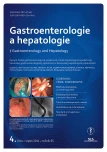Single-balloon enteroscopy in patients with Crohn’s disease – single centre’s experience
Authors:
N. Machková 1; M. Bortlík 1,2; E. Bouzková 1; D. Ďuricová 1; Luděk Hrdlička 1; M. Lukáš 1,3
Authors‘ workplace:
Klinické a výzkumné centrum pro střevní záněty ISCARE Lighthouse a 1. LF UK Praha
1; Interní klinika, 1. LF UK a ÚVN Praha
2; Ústav klinické biochemie a laboratorní diagnostiky, 1. LF UK Praha
3
Published in:
Gastroent Hepatol 2011; 65(4): 215-219
Category:
IDB: Original Article
Overview
The new endoscopic procedures, capsule endoscopy and balloon-assisted enteroscopy, introduced in clinical practice in the last ten years, have significantly increased current diagnostic possibilities in patients with Crohn’s disease (CD). The authors evaluate retrospectively the results of single-balloon enteroscopy in patients with suspected or established diagnosis of CD. Thirty--eight single-balloon enteroscopic investigations were performed in 35 patients. Successful deep intubation of the small intestine was achieved in 97 % of procedures. In individuals with suspicion on small intestinal CD a positive finding was detected in only one patient. In patients with well known diagnosis of CD, single-balloon enteroscopy provided an evaluation of mucosal healing after the therapy, and in one-third of individuals severe inflammatory changes were revealed, leading to a change in therapeutic strategy. One-third of patients also underwent, besides the enteroscopy, a therapeutic endoscopic procedure, mostly dilatation of strictures by TTS balloon. The major advantages of single balloon compared to double-balloon enteroscopy are: lower cost of the equipment, easier technical aspects of the investigation and shorter learning time for endoscopists. The disadvantage is the lower frequency of total small intestine investigations.
Key words:
Crohn‘s disease – small intestine – single-balloon enteroscopy – double-balloon enteroscopy
Sources
1. Podolsky DK. Inflammatory bowel disease. N Engl J Med 1991; 325(13–14): 928–937.
2. Tachecí I, Bureš J, Dědek P et al. Kapslová endoskopie; Nukleus HK 2008: 180–195.
3. Cheifetz AS, Kornbluth AA, Legnani P. The risk of retention of the capsule endoscopy in patients with know or suspected Crohn´s disease. Am J Gastroent 2006; 101(10): 2218–2222.
4. Yamamoto H, Sekine Y, Sato Y et al. Total enteroscopy with a non-surgical steerable double-balloon method. Gastrointest Endosc 2001; 53(2): 216–220.
5. Yamamoto H, Kita H, Sunada K et al. Endoscopic diagnosis and treatment of small intestinal diseases using the double-balloon enterscopy. Gastrointest Endosc 2004; 59(5): P100.
6. Kopáčová M, Rejchrt S, Tachecí I et al. Endoskopické vyšetření tenkého střeva pomocí dvojbalónové enteroskopie Čes a Slov Gastroent a Hepatol 2006; 60(4): 173–177.
7. Gerson LB, Flodin JT, Miyabayashi K et al. Balloon-assisted enteroscopy: technology and troubleshooting. Gastrointest Endosc 2008; 68(6):1158–1168.
8. Tsujikawa T, Saitoh Y, Andoh A et al. Novel single-balloon enteroscopy for diagnosis and treatment of the small intestine: preliminary experiences. Endoscopy 2008; 40(1): 11–15.
9. Oshitani N, Yukawa T, Yamagami H et al. Evaluation of deep small bowel involvement by double-balloon enteroscopy in Crohn´s disease. Am J Gastroent 2006; 101(7): 1484–1489.
10. Sunada K, Yamamoto H, Yano T et al. Advances in the diagnosis and treatment of small bowel lesions with Crohn´s disease using double-ballon endoscopy. Therap Adv Gastroenterol 2009; 2(6): 357–366.
11. Bourreille A, Ignjatovič A, Aabakken L et al. Role of small-bowel endoscopy in the management of patients with inflammatory bowel disease: an international OMED-ECCO consensus. Endoscopy 2009; 41(7): 618–637.
12. Van Assche G, Dignass A, Panes J et al. The second European evidence-based consensus on the diagnosis and management of Crohn´s disease: Definitions and diagnosis. J Crohn´s & Colitis 2010; 4(1): 7–27.
13. Graham DY, Opekun AR, Willingham FF et al. Visible small-intestinal mucosal injury in chronic NSAID users. Clin Gastroenterol. Hepatol 2005; 3(1): 55–59.
14. Sunada K, Yamamoto H, Kita H et al. Endoscopic balloon dilatation therapy for small intestinal strictures with Crohn´s disease using double-balloon endoscopy. Gastrointest Endosc 2007; 65: AB91.
15. Gerson I, Chiorean M, Tokar J et al. Complications associated with double balloon enteroscopy: the US experience. Am J Gastroenterol 2008; 103: 109–110.
16. Kopáčová M, Rejchrt S, Tachecí I et al. Hyperamylasemia of uncertain significance associated with oral double-ballon enteroscopy. Gastrointest Endosc 2007; 66(6): 1133–1138.
17. Mensink PBF, Haringsma J, Kucharczik T et al. Complications of double balloon enteroscopy: a multicenter survey. Endoscopy 2007; 39(7): 613–615.
18. Aktas H, de Ridder L, Haringsma J et al. Complications of single-balloon enteroscopy: a prospective evaluation of 166 procedures. Endoscopy 2010; 42(5): 365–368.
19. Hrdlička L. Doporučený postup pro vyšetřování tenkého střeva u pacientů s Crohnovou chorobou. Gastroent Hepatol 2011; 65(2):65–69.
20. May A, Farber M, Aschmoneit I et al. Prospective multicenter trial comparing push-and-pull enteroscopy with the single- and double-balloon techniques in patients with small-bowel disorders. Am J Gastroenterolog 2010; 105(3): 575–581.
21. Domagk D, Mensink P, Aktas H et al. Single- vs. double-ballon enteroscopy in small-bowel diagnostics: a radomized multicenter trial. Endoscopy 2011; 43(6): 472–476.
Labels
Paediatric gastroenterology Gastroenterology and hepatology SurgeryArticle was published in
Gastroenterology and Hepatology

2011 Issue 4
Most read in this issue
- Standard of the Czech Society of Gastroenterology for capsule endoscopy of the small intestine
- What to do when invasive colorectal carcinoma is found in endoscopic resection specimens?
- Autoimmune pancreatitis in a patient with Crohn’s disease
- Single-balloon enteroscopy in patients with Crohn’s disease – single centre’s experience
